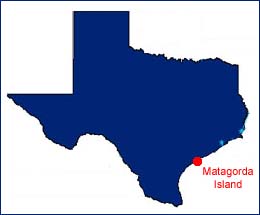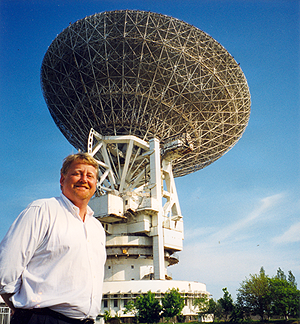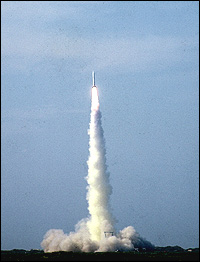Part One – Matagorda Spaceport: Searching for a Home for a Workhorse
The search for a launch site for Space Services Inc.’s planned private space transportation business began in October 1980, as the company prepared for the launch attempt of the liquid fueled Percheron (named for a sturdy breed of Belgian draft horses) rocket scheduled for 1981.
Space Services was originally incorporated, and operated early on, as Transportation Development, Inc. As the first TDI employee hired by David Hannah, Jr. – Space Services’ founder – I travelled to Vandenberg Air Force Base, California to meet with Major Rick Boller about launching the liquid-fueled rocket I’d just seen under construction in a Sunnyvale warehouse, from Vandenberg.
We had received an “invitation” from the Air Force for the meeting after an inquiry from Vice President Bush’s office on our behalf was sent through channels. The Vice President was a long time friend of David Hannah’s, and had offered to help us find a path through the DoD labyrinth. Initial discussions gave us hope that we could become a “sponsored activity” at the Western Space and Missile Center. Of course there would be a requirement for Space Services to provide some initial funding as the Air Force worked our request through their system.
Our visit was accommodated respectfully, as befits guests of the Vice President, but we were clearly well outside of the standard contractor box. Major Boller showed us some abandoned launch pads that might be renovated to support Percheron, schooled us on the tough environmental regulatory environment we would enter (“You can’t put a shovel in the ground around here without filing an Environmental Impact Statement”), and introduced us to the PI – Program Introduction – process of paperwork that would need to flow before any decision about our request could be made. When he asked: “Do you guys want the dental plan?” I knew that our launch schedule and budget were in trouble.
On the flight back to Washington, D.C. that I’d almost missed it because of a flat tire – “An omen?” I wondered – I thought about the challenging road ahead to secure approval for use of Vandenberg. I reported back to David who huddled with Gary Hudson – Percheron’s designer and builder – and quickly a decision was made to look for an alternative, all private, launch site.

A Space Services, Inc. employee climbs the Percheron Launch Tower on Matagorda Island, Texas ca. 1981.
There ensued a big debate among all the Percheron parties as to where to locate. Off shore was favored by some as the best means to avoid potentially oppressive US government regulations. Australia was a leading candidate because of David’s business connections there.
Space Services’ corporate attorney authored a legal opinion paper that argued that the United States had no rights under the 1967 United Nations Outer Space Treaty to regulate space launches from its territory by US companies. David asked me to submit the opinion to the right people in Washington, who turned out to be the Department of State. Our attorney’s opinion suggested that sufficient laws and regulations already existed to authorize SSI’s activities and no additional regulation was required to comply with the Treaty.
Would the U.S. agree with this interpretation? Again the internal debate roiled. The California contingent, led by Gary and supported by our legal counsel, suggested a “launch first, seek legal validation later” approach to the launch of Percheron. The Washington, D.C. contingent – led by me and supported by our D.C. lawyers and political advisors – counseled a different approach. Our argument was that it would be better to “run the traps” of the legal and regulatory process first, hence demonstrating to investors and customers that our proposed private space launch business had stable prospects.
The argument was ultimately settled in David Hannah’s mind when I introduced him to Walter Pennino, who would become our media and pr advisor. Walt was a veteran of the NASA Headquarters Public Affairs operation – indeed, he had been the NASA Public Affairs man for John Glenn’s triumphant world tour following his 1962 orbital flight and had served as NASA’s liaison for Vice President Agnew’s trip to Cape Canaveral to witness the Apollo 11 lunar launch. Walt listened carefully to our story of a private rocket under development and our intention to launch later that summer and said, simply, “This is a huge story. You can’t keep it secret and you shouldn’t try.”
Shortly thereafter, the decision became a no brainer when we received a letter of response from the U. S. Department of State to our legal counsel’s opinion. “While we will give careful consideration to that opinion, we would be remiss were we to leave you with the impression that the Department has accepted that view.”
 The decision was to launch from Texas, specifically private land in Matagorda County that was owned by a friend of Mr. Hannah. Our legal counsel was instructed to obtain whatever licenses and approvals might be required and the launch tower for Percheron was shipped to South Texas and assembled on an abandoned runway on one of our investors’ property.
The decision was to launch from Texas, specifically private land in Matagorda County that was owned by a friend of Mr. Hannah. Our legal counsel was instructed to obtain whatever licenses and approvals might be required and the launch tower for Percheron was shipped to South Texas and assembled on an abandoned runway on one of our investors’ property.
It wasn’t the first time Matagorda County, Texas had been considered for rocket launching. NASA had previously looked at the area as a possible location for its Space Shuttle launches. NASA’s Shuttle Source Selection Board concluded: “From an initial review, a site in the Matagorda County, Texas vicinity has potential to accommodate much of the total program at a single site.” The Matagorda site offered potential advantages as a single location vs. the planned east coast/west coast locations needed to meet Department of Defense needs. For many reasons, including the need “to consider the bird sanctuary near Matagorda Island,” the Board recommended against the Matagorda County option.
Percheron was not the Space Shuttle. Indeed, the initial flight would be a partially-fueled, suborbital (30,000 feet altitude) hop, basically a non tied-down engine test. The proposed South Texas site was available, near to Houston, and affordable. There was only one problem — NIMBY or Not In My Back Yard.
To be continued…


